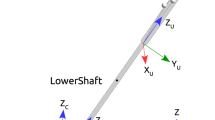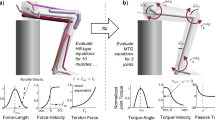Abstract
Forward dynamics golf swing simulations are important to gain insight into how a golfer should swing a particular club and which design improvements should be considered by golf club manufacturers. A new method of optimizing a four degree-of-freedom (DoF) biomechanical golfer model swinging a flexible shaft with a rigid clubhead was developed using a direct orthogonal collocation approach. The kinematic and kinetic results of the simulation confirm previous findings on optimal joint angle trajectories, shaft deflection patterns, and joint torque profiles in a golf swing. This optimization approach is a promising development in biomechanics research, and future work will implement this method in three-dimensional swing models that have been shown to have higher robustness and fidelity.





Similar content being viewed by others
References
Economic Impact of Golf in Canada (2014). Online. Accessed 10-December-2018. http://canadagolfs.ca/wp-content/uploads/2014/06/SNG-Golf-2014-Executive-Summary-FINAL-Report-JUNE-2_ENG.pdf
Betzler, N., Monk, S., Wallace, E., Otto, S.R., Shan, G.: From the double pendulum model to full-body simulation: evolution of golf swing modeling. Sports Technol. 1(4–5), 175–188 (2008)
Cochran, A., Stobbs, J.: The Search for the Perfect Swing: An Account of the Golf Society of Great Britain Scientific Study. Heinemann (1968)
Jorgensen, T.P.: The Physics of Golf, 2nd edn. Springer, New York (1999)
Lampsa, M.A.: Maximizing distance of the golf drive: an optimal control study. J. Dyn. Syst. Meas. Control 97(4), 362–367 (1975)
Sprigings, E.J., Neal, R.J.: An insight into the importance of wrist torque in driving the golfball: a simulation study. J. Appl. Biomech. 16(4), 356–366 (2000)
MacKenzie, S.J., Sprigings, E.J.: A three-dimensional forward dynamics model of the golf swing. Sports Eng. 11(4), 165–175 (2009)
Balzerson, D., Banerjee, J., McPhee, J.: A three-dimensional forward dynamic model of the golf swing optimized for ball carry distance. Sports Eng. 19(4), 237–250 (2016)
McNally, W., McPhee, J.: Dynamic optimization of the golf swing using a six degree-of-freedom biomechanical model. In: MDPI Proceedings of the 12th Conference of the International Sports Engineering Association, vol. 2, no. 6 (2018)
Yeadon, M.R., King, M.A.: Evaluation of a torque driven simulation model of tumbling. J. Appl. Biomech. 18, 195–206 (2002)
King, M.A., Wilson, C., Yeadon, M.R.: Evaluation of a torque driven-model of jumping for height. J. Appl. Biomech. 22, 264–274 (2006)
Kentel, B.B., King, M.A., Mitchell, S.R.: Evaluation of a subject-specific, torque-driven computer simulation model of one-handed tennis backhand ground strokes. J. Appl. Biomech. 27(4), 345–354 (2011)
Rao, A.V.: A survey of numerical methods for optimal control. Adv. Astronaut. Sci. 135(1), 497–528 (2009)
Laschowski, B., Mehrabi, N., McPhee, J.: Optimization-based motor control of a Paralympic wheelchair athlete. Sports Eng. 2, 1–9 (2018)
De Groote, F., Kinney, A.L., Rao, A.V., Fregly, B.J.: Evaluation of direct collocation optimal control problem formulations for solving the muscle redundancy problem. Ann. Biomed. Eng. 44(10), 2922–2936 (2016)
De Leva, P.: Adjustments to Zatsiorsky–Seluyanov’s segment inertia parameters. J. Biomech. 29(9), 1223–1230 (1996)
Sandhu, S., Millard, M., McPhee, J., Brekke, D.: 3D dynamic modelling and simulation of a golf drive. Proc. Eng. 2(2), 3243–3248 (2010)
McNally, W.: Forward Dynamic Simulation of a Golf Drive: Optimization of Golfer Biomechanics and Equipment. Master’s thesis, University of Waterloo (2018)
Patterson, M., Rao, A.: GPOPS II: a MATLAB software for solving multiple-phase optimal control problems using hp-adaptive Gaussian quadrature collocation methods and sparse nonlinear programming. ACM Trans. Math. Softw. 41, 1–37 (2012)
Bastian, A.J., Zackowski, K.M., Thach, W.T.: Cerebellar ataxia: torque deficiency or torque mismatch between joints? J. Neurophysiol. 83, 3019–3030 (2000)
Quintavalla, S.: A generally applicable model for the aerodynamic behavior of golf balls. In: Science and Golf IV: Proceedings of the 2002 World Scientific Congress of Golf, pp. 341–348 (2002)
Acknowledgements
The authors acknowledge financial support from McPhee’s Tier I Canada Research Chair in Biomechatronic System Dynamics.
Author information
Authors and Affiliations
Corresponding author
Additional information
Publisher’s Note
Springer Nature remains neutral with regard to jurisdictional claims in published maps and institutional affiliations.
Rights and permissions
About this article
Cite this article
Brown, C., McNally, W. & McPhee, J. Optimal control of joint torques using direct collocation to maximize ball carry distance in a golf swing. Multibody Syst Dyn 50, 323–333 (2020). https://doi.org/10.1007/s11044-020-09734-0
Received:
Accepted:
Published:
Issue Date:
DOI: https://doi.org/10.1007/s11044-020-09734-0




